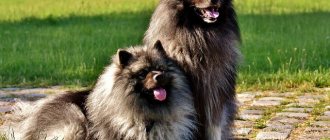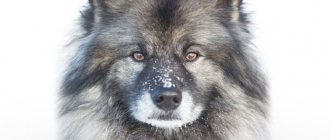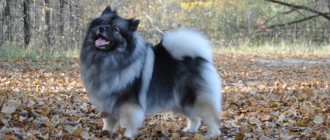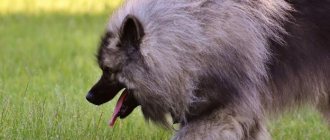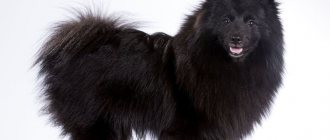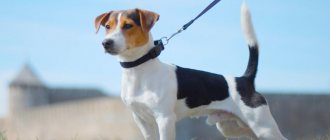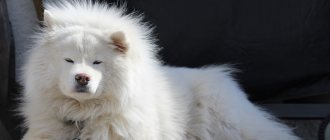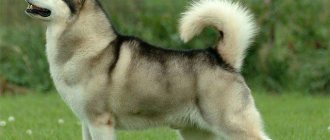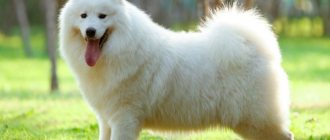History of the origin of the breed
The first mentions of this breed appeared in the 16th-17th centuries in Holland. Gray Keeshonds were used to guard houses and ranches; the dogs helped in herding sheep; the dog was a resident of almost every commoner's estate.
The Dutch often called this breed "barge dog". Sailors loved it and used it to protect sea barges. They also took them on a voyage; the dogs miraculously sensed the approach of other ships and barked loudly, thereby saving both ships from a collision. There was even a sign that said that if there was a barge dog on the ship, the ship would return to the harbor safe and sound.
The world could have lost the Keeshond during the revolution in Holland, since the popular revolt collapsed and everything connected with it was destroyed. And due to the fact that the cute Spitz often appeared with the main rebel, it was decided to exterminate the dog’s pedigree, but this was not completely accomplished.
At the beginning of the 21st century, the first Keeshond breed club was opened in Germany, and in 1899 its standard was introduced, which is still in effect today.
Modern Keeshonds became popular in the United States after the dogs won a tracking competition in 1983. These dogs are recognized as the best search engines, thanks to their fine sense of smell, excellent intuition and ringing bark. Nowadays, Keeshond kennels are registered in each of the 50 states.
The breed has found itself in helping people with disabilities and developmental disabilities. Previously, specialist dogs undergo special training, after which they participate in treatment sessions aimed at improving the physical and psycho-emotional functioning of people with special needs. In addition to Spitz dogs, hospice patients easily communicate with golden retrievers and Labradors.
Doctors note that the presence of Keeshonds in treatment with animal therapy gives a positive effect much faster. Spitz dogs appeared in the CIS in the 80s, successfully performing in circus performances, but they did not leave offspring. But breeders paid attention to them, which contributed to the spread of Keeshond nurseries in the CIS.
History of this breed
You're probably wondering where this breed came from. The Wolfspitz is one of the most ancient dog breeds, which makes the history of its origin even more interesting.
And so, this breed takes its origins from the Netherlands. In the 18th century there was a civil protest against the authorities, which later grew into a whole uprising.
The leader of this protest carried with him everywhere a spitz of impressive size, somewhat reminiscent of a wolf.
Subsequently, this Spitz became a symbol of this uprising. Unfortunately for the people, the riot failed and all dogs of this breed began to be rapidly exterminated in order to destroy any memory of the failed protest.
But, there were a number of individuals left that were transported to Germany, where they got their name - Wolfspitz.
Description of the breed
The Keeshond is the largest species in its group, which includes Spitz:
- American;
- Danish;
- Indian;
- German;
- Finnish;
- Japanese;
- Florentine
- Pomeranian;
- Norrbotten;
- Korean yellow spitz;
- Nenets Laika.
The Keeshond is also called the German Wolfspitz. Wolf in English means wolf. Namely, this breed has a gray wolf coat color; this dog has nothing else in common with a wolf.
The color is usually not monochromatic, but with transitions from dark shades of gray on the back and face of the animal to light gray on the paws, belly and tail. The breed standard allows for the presence of tan shades of Keeshond, although there are breeders who have bred other colors, but they are not recognized by the standard.
coat is long, coarse and thick, which is why it sticks out vertically and does not mat.
Especially long hair on the neck, like a lush mane, and around the hind legs, like pants. At the same time, the Keeshond's coat is not subject to matting; rarely, with improper or insufficient care, tangles can form above the ears, in the groin, and in the armpits.
The fur on the face is smooth and short, usually dark in color.
The undercoat is often light shades, of medium length, in the form of small spirals: gray, silver, milky.
Unlike most breeds with long hair, the Keeshond does not require special care. It is enough to brush your dogs several times a week with a special brush and lightly brush them daily. It is not necessary to groom dogs during the warm season. A haircut may result in the dog not being admitted to the show and being excluded from breeding.
The compact, harmoniously built Keeshond has a triangular muzzle shaped like a fox.
The ears are erect, pointed and black in color.
The nose is black, moderately moist.
The eyes are dark brown, almond-shaped, medium in size with characteristic dark spots around the eyes, reminiscent of glasses; some individuals even have so-called black stripes in the pattern from the eye to the ear, the temples of the glasses.
The look is smart and mischievous at the same time.
The back is short, straight with a slightly convex loin.
tail is set high, fluffy with a black tip, formed into a ring and pressed tightly to the back.
The paws are strong and widely set.
The belly is well tucked and does not sag.
The chest is deep with a smooth transition.
Moves with light movements with a slightly springy gait.
The height at the withers does not exceed 45 cm.
weight is between 25-30 kg.
Character and behavioral characteristics
Keeshonds have a low level of aggression, this is the main reason why this breed is recognized as a family breed. But they bark often and loudly, with the help of their voice they rejoice, play, communicate, and notify of danger. If a person has been away from home for a long time, then upon his return the pet will bark loudly and try to share the events in the house.
The Keeshond is active and energetic; walks with it should be long and active, especially until the age of 3, then they become less restless. You can walk with your pet in any weather; Keeshonds have excellent thermoregulation, so they do not freeze in winter and do not suffer from heat in summer.
At home, the dog does not get bored and usually finds a secluded place where he spends most of his time between walks. The peace-loving dog gets along well with cats and other dogs.
Easily makes contact with people, but is careful with strangers. He loves children and willingly plays with them, tolerates their pranks and does not show aggression. Pets of this group feel the mood and sincerely empathize with the owner and all family members.
Education and training
The breed has successfully proven itself at exhibitions and various competitions. The smart and quick-witted Wolfspitz is easy to train. The dog is so loyal to the person that it is ready to do anything to please its companion.
It is important for the owner to find contact with the pet and learn to understand it. Unlike most dogs, the Keeshond may refuse treats when following commands; these beauties prefer feelings: praise, love and care are the best rewards for them. There is no need to scold and punish a Wolfspitz; adults understand intonation very well; more persistence and patience should be shown in training.
During walks, the dog enjoys playing with a ball, performing tricks on obstacle courses, and running. It is better to let your pet off a leash only for the duration of training; its adventurous nature requires new experiences, so you should not walk dogs without a leash, they can run away and get lost.
Due to its high activity during walks, this breed is not recommended for older people.
Diseases and care
Among dogs, the Keeshond has received the title of long-liver, their average life expectancy is 15 years. This breed is not very common and is not used to produce puppies for sale, so the breed is resistant to diseases and pathologies. Rarely, individuals may be found with diseases of the hip joints, diseases of the kneecaps, heart and skin. Wolfspitz dogs are also susceptible to hypothyroidism. Injuries are also very rare for the Spitz group.
Keeshonds are not fussy about grooming, which is facilitated by their natural cleanliness. Particular attention should be paid to their fur; the pet must be thoroughly combed at least twice a week; if necessary, the procedure must be carried out more often.
It is recommended to bathe your dog once a month with a specialized shampoo and conditioner. Then use a hair dryer to dry your hair in the direction of its growth. It is not recommended to cut these dogs due to the fact that the fur may lose the protective functions that provide its elasticity and shape.
General description of Wolfspitz
First, it’s worth learning more about the breed itself. We present to you a brief description of the Wolfspitz.
Size. Dogs of this breed are quite impressive in size. In addition, the Wolfspitz is the largest of the Spitz group. The height of this breed is around 50 cm, and the average weight is 20 kg.
Wool. Wolfspitz are very fluffy and their coat is quite thick.
Note!
Nicknames for dogs for boys - easy, rare and most beautiful names for dogs in alphabetical order
Nicknames for girls' dogs - a list of beautiful, funny, unusual nicknames for large and small dog breeds
Maltipoo dog - everything about the dog from A to Z. Photos, description of the breed, character, maintenance features, prices, reviews
Purpose. The main function of this breed is to guard a home or any other territory. With proper and competent training, it can take on the role of a watchdog. Not suitable for permanent protection of a specific person.
Feeding and diet
Spitz are unpretentious in nutrition, and it is not so easy to spoil them. They can eat both homemade food and ready-made food. Prepared food should be balanced in vitamins and minerals, warm, fresh, and low-fat.
There is no need to feed these dogs from the table; this quickly becomes a habit of the pet, and it becomes an extortionist. You should not feed your dog fried foods, smoked meats and sweets, as this can lead to gastrointestinal diseases. An adult dog eats twice a day, Keeshond puppies eat 4-6 times.
It is advisable to feed the animal at the same time and remove the bowl after eating. Clean water should always be freely available. If the dog does not eat a portion, this may be a sign of some health problems. You should not include snacks in your diet, as this can lead to obesity in your dog.
Price and where to buy a puppy
The average price for a Keeshond puppy from a breeding kennel can vary between 500-1500 USD (36,000-110,000 rubles), the price can be higher, it largely depends on the titles of the baby’s parents. From a private breeder, a puppy of this breed costs 300-400 USD (22,000-30,000 rubles).
From 2-3 months of age you can take your Spitz to a new home. It is imperative to show the baby to the veterinarian, because young offspring, unlike adults, have weak immunity that is not resistant to viruses.
Choosing a Keeshond puppy
Dogs of this breed are bred in kennels.
The choice of a Keeshond puppy should be taken very seriously. And you need to start by finding a reputable breeder to whom you can turn for advice in the future.
Nurseries
Today in our country Keeshond can be purchased both in single-breed nurseries and in nurseries of dogs of several breeds. The breeders achieved excellent results: in 1998, five of the seven Keeshonds presented at the international exhibition became world champions. You can meet nursery employees at the exhibition and communicate on specialized websites and forums.
What to pay attention to
When you arrive at the breeder, look at the living conditions of the animals. Ask breeders about testing for genetic diseases. Examine your parents. The exterior of each of them must meet the standard. A weak, nervous or apathetic dog is a reason to be wary. Puppies must be healthy, reasonably well-fed and playful. Be sure to inspect the skin and coat, check the bite. You must be provided with vaccination documents, pedigree, and mating certificate.
Puppy price
The Keeshond is not a cheap dog. The price is influenced by gender, class, parents' regalia and purpose of purchase. The prestige of the kennel automatically increases the price of the puppy. Pedigree bitches for breeding the breed are the most expensive. A future companion who cannot participate in exhibitions will cost several times less.
The price for a puppy from hand starts from 10,000 rubles. The cost of a puppy from a kennel starts from 20,000 rubles.
Briefly about the main thing
- The modern name for barge dogs appeared in Holland, where the dog served on ships or in private households;
- Medium-sized dogs with lush hair and a harmonious physique are recognized as long-living;
- Wolfspitz prefers to take active walks and relax at home, choosing a secluded place for this;
- The breed is easy to train with the praise management method; treats are not a stimulus for them;
- Spitz rarely get sick and are in good health even in old age;
- When building a diet, it is important to maintain not only the diet, but also the frequency of meals at the same time;
- The price depends on the pedigree and origin of the dog, as well as on the awards received by its parents.
Wolfspitz puppies
Of course, you need to buy a Wolfspitz at an early age, when he is still a puppy. It all depends on the purpose for which you will have a Wolfspitz puppy.
If it’s just for the home, then it’s worth buying from the same ordinary people.
But, if you decide to show your Wolfspitz at exhibitions, then you need to take the dog from specialized kennels.
Photo
Video
The Keeshond is an intelligent breed of dog with an obedient character. The animal quickly gets used to the family and becomes not just a favorite of the household, but their friend and companion. The dog's non-aggressive, playful disposition allows him to get along in families with small children. The cleanliness and unpretentiousness of the breed greatly simplifies the care and maintenance of the pet. We are interested in the opinion of the owners, what approach did you find in raising your pet, did he have allergies, how does molting proceed? What disadvantages do Spitz dogs have? Do they have guard qualities or is it more of a decorative breed? Share your stories with us.
Pros and cons of the breed
Advantages and disadvantages of the breed:
| pros | Minuses |
| Faithful friend and companion | Can bark loudly |
| Gets along well with other pets | Careful grooming required |
| Non-aggressive |
The breed is not very common in Russia, so you will have to look for it.
Where to buy and price
It is better to buy a puppy from nurseries. It is advisable to visit exhibitions and read reviews. Most breeders have forums where you can ask all your questions. There are several nurseries: Widges Pride (in Belarus), Olympic Spirit, Aistraum and others. The price depends on the class of the puppy, ranging from 15,000 to 40,000 rubles.
When choosing a puppy, you should pay attention to the parents, since they inherit the appearance and character. The baby is chosen with a characteristic wolf coloring, which appears at 2-3 months of age; he must have a good pedigree and medical certificates.
The Wolfspitz is an exemplary pet who gets along not only with all family members, but also with pets.
